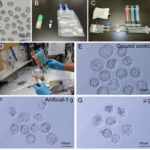2023-10-27 バッファロー大学(UB)

Study published in May 2023 shows the benefit of using at-home rinses for diabetic patients who are being treated for gum disease.
◆この研究は、歯周炎の初期治療に一般的に使用されるスケーリングおよび根面平坦化(SRP)に加え、自宅での抗プラーク治療の効果を調査し、特に糖尿病患者に焦点を当てました。
◆研究の結果、糖尿病患者が口腔うがい薬を使用することで歯周組織の炎症が減少し、口内の細菌が除去され、治癒が向上した一方、非糖尿病患者には追加の処置が効果がありませんでした。この研究は糖尿病患者に特有の口腔ケア方法の重要性を強調し、一般的なアプローチとの違いを示しています。ただし、さらなる研究が必要で、Diaz博士は口腔内細菌叢が糖尿病に与える影響についての研究を進めています。
<関連情報>
- https://www.buffalo.edu/news/releases/2023/10/Diaz-gumdisease-study-diabetes.html
- https://journals.sagepub.com/doi/10.1177/23800844231167065
歯周治療の補助として化学機械的歯垢除去レジメンを試験する無作為化試験。 Randomized Trial to Test a Chemo-Mechanical Antiplaque Regimen as Adjunct to Periodontal Therapy.
K.L. Falkner,S. Cervi,S. Andrusz,Y. Shimizu,J.J. Zambon,K.L. Kirkwood,R.E. Schifferle,P.I. Diaz
JDR Clinical and Translational Research
DOI:https://doi.org/10.1177/23800844231167065
Abstract
Background:
The control of dental biofilm regrowth after nonsurgical periodontal therapy is associated with better clinical outcomes. However, many patients have difficulty achieving optimal plaque control. Subjects with diabetes, in which immune and wound-healing responses are typically impaired, may benefit from intensive antiplaque control regimens after scaling and root planing (SRP).
Objectives:
This study aimed to evaluate the effects of an intensive, at-home, chemical, and mechanical antiplaque regimen as an adjunct to SRP for the treatment of moderate to severe periodontitis. A secondary objective was to compare responses in subjects with type 2 diabetes and nondiabetics.
Methods:
This was a 6-mo, single-center, parallel-group, randomized trial. The test group received SRP and oral hygiene instructions, and subjects were instructed to use a 0.12% chlorhexidine gluconate mouthrinse twice a day for 3 mo and utilize rubber interproximal bristle cleaners twice a day for 6 mo. The control group received SRP and oral hygiene instructions. The main outcome was change in mean probing depth (PD) from baseline to 6 mo. Secondary outcomes included change in sites with deep PDs, mean clinical attachment level, bleeding on probing, plaque index, hemoglobin A1C, fasting blood glucose, C-reactive protein, and taste assessment. This study was registered at ClinicalTrials.gov as NCT04830969.
Results:
In total, 114 subjects were randomized to either treatment. Eighty-six subjects completed the trial with no missing visits. Neither an intention-to-treat nor a per-protocol analysis showed statistically significant differences between treatment groups in mean PD at 6 mo. In a subgroup analysis, subjects with diabetes in the test group showed a statistically significant greater reduction in mean PD at 6 mo when compared to subjects with diabetes receiving the control treatment (Δ = 0.15, P = 0.04), while there were no differences within nondiabetics (Δ = 0.02, P = 0.75).
Conclusion:
Outcomes in subjects with diabetes may be improved by chemo-mechanical antiplaque measures after nonsurgical periodontal therapy.
Knowledge Transfer Statement:
This study suggests diabetic subjects may benefit from an intensive, at-home, chemical, and mechanical antiplaque regimen to improve nonsurgical periodontal therapy outcomes.


